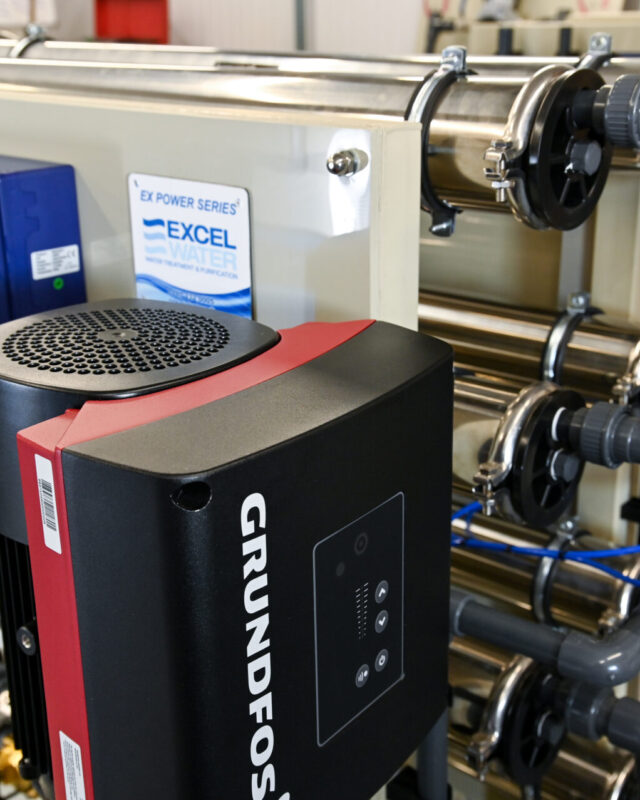

Removes The Hardness
From Your Water
Hard water is present across a large proportion of the UK and contains high level of minerals such as calcium and magnesium. These minerals can build up on machinery, forming scale deposits that can be damaging and reduce the efficiency of processes. Scale build-up can cause precision machinery to be inaccurate and cause damage to internal parts and occasionally render the equipment unrepairable.



Commercial Water
Softeners
The process of removing mineral ions from a water system is called water softening and is done on a commercial scale for businesses that use a large amount of water for production.
Commercial water softeners reduce scale and limit the damage done to machinery over time. Water softening provides a steady supply of soft water to keep processes working efficiently, reduce energy costs and limit machine downtime.
For industrial boilers, hardness can cause large scale build ups and reduce efficiency of the heating element; resulting in using more power and higher energy costs.
Water softening plants are frequently used as pre-treatment before a Reverse Osmosis unit to protect the membranes from hardness deposits.


Key Benefits
- Prevents scale build up to reduce expensive acid descales or full boiler replacements involved.
- Acts as a barrier, protecting your key equipment.
- Minimum checks and salt top up required!
- Valve control so automatic regenerations, no manual actions required.



How Do Commercial
Water Softeners
Work?
Water softeners work by a process known as ion exchange. The hard water passes through a high-quality cation exchange resin column inside a pressure vessel. The resin removes the positively charged Calcium and Magnesium ions from the solution and exchanges them for the ions of Sodium. When the resin becomes exhausted it is regenerated by drawing a solution of common salt called brine through the column.
During regeneration, the hard metal ions are then released from the resin and replaced again with those of Sodium from the brine. The unwanted ions are flushed to drain along with the excess brine. Regeneration takes between 60 to 180 minutes depending on the size of the softener.
Use our commercial water softener sizing tool
Common Questions on Water Softening
How To Size A Commercial Water Softener?
The size of a water softener is determined by the exchange capacity required by the application. Accurate sizing is essential to ensure a continuous flow of soft water and to guarantee that the softener is operating efficiently. The volume can be adjusted for different levels of hardness. The continuous flow rate required affects the size of valve that can be used and sometimes the size of the resin column. The minimum pressure required is 2 bar and the maximum is 8 bar. All softeners require an electrical supply of 240v.
The size, volume and capacity of your softener will be assessed during a site survey with a senior design engineer.
How To Maintain A Commercial Water Softener System?
Maintaining a commercial water softening system includes keeping the salt at the required levels to make the brine for regeneration purposes. Salt is typically supplied in 25kg bags and users are required to regularly top up the level of salt in the brine tank to ensure a saturated brine solution is available.
We recommend water softening plants are serviced every six months to re-grease moving parts which could cause issues. Consistent servicing every six months will ensure many years of reliable service from the plant.
Which Is The Right Water Softening System For Me?
There are two main types of water softener in the water treatment industry: a Simplex Water Softener; and a Duplex Water Softener.
Simplex Water Softening Plant
A simplex water softener must regenerate every so often depending on flow rate and usage. They are best suited to consistent demand applications of moderate total water consumption. Regeneration is controlled by the multiport valve head assembly. Time clock and delayed regeneration meter-controlled softeners are normally programmed to regenerate at 2.00am or at a convenient period of low water usage.
Duplex Water Softening Plant
A duplex water softener supplies a constant supply of softened water. This is essential for companies who need to run their plant 24 hours. Duplex systems use two resin columns; one in service with the second on standby. The water flow to service is metered and when the service column is exhausted, the control valve automatically switches back to the first column again. Duplex softeners are normally sized to give one regeneration per column per day, but each column can be regenerated more frequently if required. Parallel run systems with both vessels online at the same time are available.



